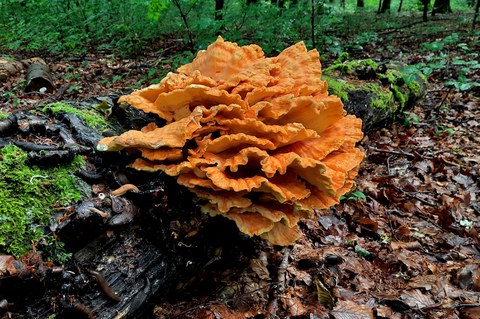Apr 22, 2024
IHI researchers help to understand what fungi do with dead wood

Der Gemeine Schwefelporling (Laetiporus sulphureus) auf morschem Laubholz im Nationalpark Hainich. Dieser Pilz bewirkt eine Braunfäule, d. h. während der Zersetzung wird vor allem die weißliche Zellulose abgebaut.
What we disrespectfully refer to as "rotting wood" in our everyday language when walking through the forest is a highly significant process for the forest ecosystem and fascinating for microbiologists in its complexity:
The decomposition of dead wood is based on a complex interaction of many specialized fungal species and their extracellular (i.e. working outside the fungal cells) degradation enzymes.
Researchers from the IHI Zittau at TU Dresden, together with colleagues from the Helmholtz Centre for Environmental Research (UFZ) and other institutions, have succeeded in analyzing and evaluating the decomposition of dead wood in great detail using proteomic (i.e. protein-related) and molecular biological methods and presenting it in a high-quality publication.
Numerous fungal digestive enzymes already known from laboratory experiments were identified in samples from the trunks of twelve decomposing tree species and assigned to specific fungal genera, such as the Hallimasch(Armillaria spp.). Enzymes involved in the degradation of cellulose and lignin (both main components of wood) worked hand in hand and were detectable in almost all samples at the same time, which indicates a so-called functional redundancy. This ultimately means that different genera of fungi in different tree species use the same types of enzymes to break down wood.
The experiments are part of the Biodiversity Exploratories(www.biodiversity-exploratories.de), which are funded by the German Research Foundation (DFG) in a priority program. The aim is to understand the effects of land use by forestry and agriculture on the diversity of different species as well as biological interactions and ecosystem services in real landscapes.
